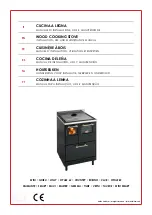
- 10 -
Lighting a fire
1. Open the door by pulling on the fixed handle under
the door edge. Then, lay kindling crosswise until you
have an approx. total quantity of wood of 1.5 kg. (Ap
-
prox. 15 pieces of kindling) (See picture below)
2. Push the damper control as far to the right as it will
go, place a couple of firelighters on top of the heap
and light. In the majority of cases, you can close the
hatch immediately after lighting.
(If the chimney is cold or if there are unfavour-
able weather conditions, you may need to keep
the door ajar during the first couple of minutes
in order to establish a satisfactory chimney
draught.)
3. Let the first fire burn down with maximum air sup
-
ply. This is to allow the stove to reach its operating
temperature quickly. Light a new fire of the desired
size and close the door. Wait a couple of minutes,
until the fire has started burning properly. Then turn
the damper to the left, until you have achieved a calm
and harmonious fire.
Note! The reason why we want to achieve the op-
timum operating temperature in the stove quickly
is that it works with the best efficiency at this
temperature. This minimises the emissions and
maximises the heat generation.
The K700 is equipped with an innovative self-
closing and self-locking door. When putting
firewood in or removing ash, carefully place the
door at 90 to 95 degrees opening angle, so the
door will stay open. Give the door a light push,
back past the 90 degrees position, and the door
closes automatically and locks.
NOTE! For further information on firing in our
stove, see the film "firing tips" on keddy.se.
CARE & FIRING INSTRUCTIONS Cont...
GOOD TO KNOW
Since it can take some time for a cold chimney to start
working properly, i.e. to force the smoke in the right direc
-
tion, you can place a firelighter on the baffle and light it.
In this way, you eliminate the downdraught and avoid the
nuisance of smoke entering the room in the initial stage.
If the premises are equipped with mechanical ventilation,
i.e. if there are one or more fans to evacuate the air from
the building, there may be such a large negative pressure
in the building that it could be difficult to light the stove. We
suggest that you turn off the ventilation temporarily or open
a window until the negative pressure has dissipated.
If there is insufficient burning material in the firebed to light
a new fuel charge, excessive smoke emission can occur.
Refuelling must be carried out onto a sufficient quantity of
glowing embers and ash that the new fuel charge will ignite
in a reasonable period. If there are too few embers in the
fire bed, add suitable kindling to prevent excessive smoke.
Operation with the door open can cause excess smoke.
The appliance must not be operated with the appliance
door left open except as directed in the instructions.
Operation with the air controls or appliance dampers open
can cause excess smoke. The appliance must not be oper
-
ated with air controls, appliance dampers or door left open
except as directed in the instructions.
Depending on the weather conditions and the length and
area of the chimney, among other things, you may also
get smoke in the room when you open the door. In order
to counteract this, open the door ajar and allow the hearth
to stabilise in relation to the additional oxygen supply, and
always wait before adding more wood until the old fire has
burnt out.
REMOVAL OF SOOT AND MAINTENANCE
Soot must be removed at least once per season. The soot
from the chimney and the connections should be removed
by a chimney sweep. The vermiculite baffle should be
removed during soot removal.
If the glass becomes sooty, it is best to use a special soot
remover, which you can buy from your local stove dealer.
Never use detergents containing abrasive materials. This
will damage the glass.
When emptying the stove, the ash should be placed in a
sheet metal container.
Pay attention to the risk of fire
when you throw out the ash, as the ash may contain
live embers for a very long time!
IMPORTANT! If there is a chimney fire, the stove door and
the supply air control must be closed. If necessary, call the
fire brigade. After a chimney fire, the chimney must be in
-
spected and approved by a certified chimney sweep before
the stove can be put into use again.
PACKAGING
The stove is delivered on an untreated wooden pallet,
which can be sorted as combustible material or burned in
the insert. Other packaging is corrugated paper or pa
-
perboard, which should be sorted and disposed of in the
intended container at your nearest recycling centre.






























